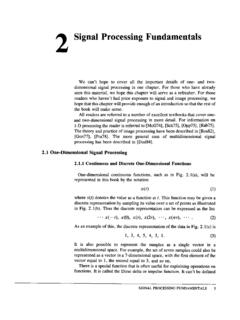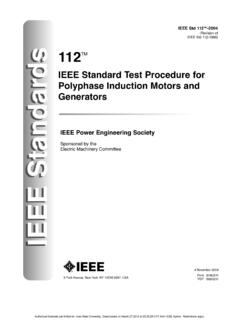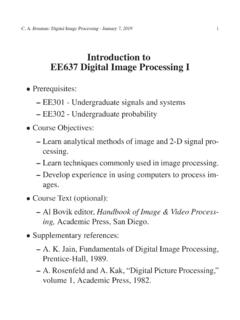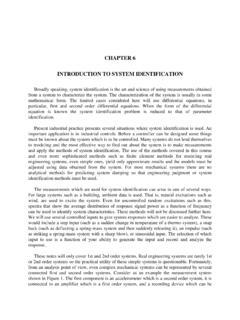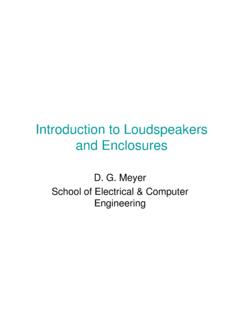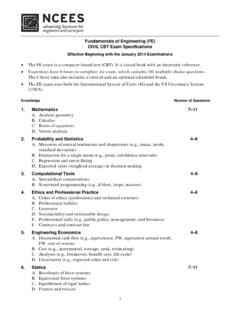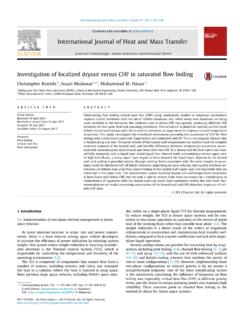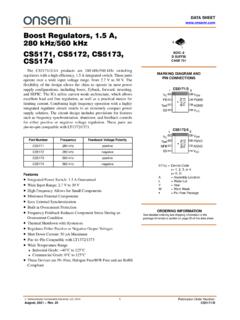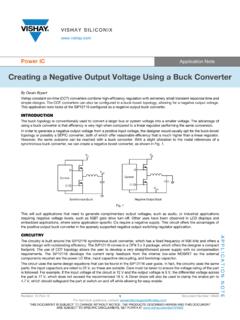Transcription of Introduction to Light Emitting Diodes (LEDs)
1 Introduction to Light Emitting Diodes (LEDs). Introduction Light - Emitting Diodes (LEDs) are promising lighting sources for general lighting applications with the promise of being more than ten times as efficient as incandescent lighting. Such characteristic combined with their long operating life and reliability has made them becoming a potential choice for next generation of lighting systems including automotive, emergency, backlight, indoor, and outdoor. To ensure proper operation and to control the Light intensity, LEDs need an efficient driver, normally implemented by power electronics-based conversion stages, to match the LED characteristics with the AC. grid voltage and to generate a controllable, high quality Light . Luminous flux is an attribute of visual perception in which a source appears to radiate or reflect Light . Brightness is a non-quantitative term that is often used to describe this characteristic. Luminous flux is measured in lumen and is the Light power measured multiplied with the V- scaling function which compensates for the human eye's sensitivity to different wavelengths.
2 The luminous flux of LEDs is largely governed by the current flowing through the device. Fig. 1 shows a typical curve characteristic of an LED (luminous flux versus the current). Fig. 1: LED Current vs. Luminous Flux [1]. Another variable that plays a significant role in the amount of luminous flux of the LED is the temperature of the LED device. Thus, it is important to control the temperature of these devices in order to maintain full control. Fig. 2 shows the relationship between the forward voltage and the forward current of an LED. As expected, the LED has a threshold forward voltage beyond which it allow current to flow through it. Once the LED voltage reaches its threshold value, its current becomes an exponential function of its voltage. Fig. 2: LED Forward Voltage vs Current [1]. Fig. 3: Forward I V characteristics of the 340 nm LED measured at 5-300 K [2]. As Fig. 2 shows, voltage control of LEDs might be possible. However, a slight increase in the temperature results in a shift in the curve characteristic to the left as can be seen in Fig.
3 3. Therefore, over time, the forward current of the LED increases which results in a higher temperature and subsequently a shift in the current, , a positive feedback. This process continues until the device fails. Therefore, a current control is the preferred control of an LED. LED Dimming Techniques The capability of reducing the intensity of output Light is called dimming. LEDs can be dimmed by controlling the forward current flowing through them. This can be achieved in two ways: Amplitude Modulation (AM) and Pulse Width Modulation (PWM). Amplitude Modulation: In AM, the dc current flowing through the LED is controlled to achieve dimming. Supplying more current to an LED increases the Light intensity, and reducing the current decreases its intensity. Typically, the current is controlled using a resistor in series with the LED (a variable resistor like a potentiometer) or a current regulator circuit. One way of dimming an LED is to use a variable resistor (potentiometer) to dynamically adjust the current received by the LED and thereby increasing or decreasing its intensity.
4 A typical AM dimming technique is shown in the circuit diagram of Fig. 4 in which by adjusting the reference value of the current feedback loop, the LED current is regulated. The closed-loop current control is to provide a stable luminous intensity and color. The resistor Rs in Fig. 4 is used to sense the voltage across this resistor and subsequently to measure the LED current. The measured value is used by the closed-loop controller to adjust the output voltage of the dc-dc converter and LED current. AM dimming works well for a single LED device. However, for a string of LEDs which are driven with their recommended forward currents, a reduction in current may turn off some LEDs before others, and dim some of them while keeping others still quite bright due to variation in the characteristics of the different LEDs. Furthermore, this might lead to spectral slide, , change in color of the lighting. Fig. 4: Block diagram of the implementation of the AM dimming technique the AM dimming technique Fig.
5 5: Block diagram of the implementation of the PWM dimming technique the PWM dimming technique Pulse Width Modulation: A more efficient way of dimming LEDs is to use the PMW dimming. In PWM dimming, the LEDs are supplied by pulse currents at high frequencies varying between the recommended forward current (for maximum brightness) and zero. The LEDs turn on when the current is high and turn off when the current is zero. In this technique, the frequency of the current is high enough to ensure that (i) the turning on and off of the LEDs are not apparent to the eye and (ii) it is outside the audible range to avoid any acoustic issues. With PWM, the strings of LED bulbs can all be driven with the recommended forward current when turned on. Dimming can be achieved by tuning the duty ratio of the current supplied to the LEDs. The higher the duty ratio is, the brighter the LED will appear to the observer due to higher average forward current being supplied to the LED. For maximum brightness, a constant current ( , the duty ratio of the current pulse is one) will be supplied to the LED.
6 The advantage of this method over the AM diming is the absence of spectral slide and uniform dimming over different LED strings. In Fig. 5, a switch is connected to the LEDs in series that switches the current flowing through the LEDs between high and zero periodically. Each of the AM and PWM dimming techniques may operate based on either a linear or a switching regulator. The linear regulator receives an input voltage and maintain a constant output voltage by dissipating energy to shed the difference between the input and output voltages. The switching regulator switches the input voltage at high frequency to maintain a regulated output voltage by varying the ratio of on-time to time period of the pulse. In a switching regulator, as compared with a linear regulator, the losses are smaller. That is, the LED drivers with switching regulators have higher efficiency than the drivers with linear regulators. Hence because of high efficiency and better illuminating quality, the PWM.
7 Dimming technique with a switching regulator is the preferred choice for LED driving systems [4]. Driver Circuits and Control In the technical literature, various dc-dc converter topologies along with their dimming techniques have been proposed/investigated for LED driving[3]-[8]. Reference [5] provides an overview of various commonly used topologies to drive LEDs and their respective control strategies. Fig. 6 shows the most commonly used dc-dc converter topologies including the non-isolated buck, boost , and buck- boost in Fig. 6(a) to (c) and an isolated dc-dc converter in Fig. 6(d). The output voltage of the converters of Fig. 6 is controlled depending upon the current demanded by the LEDs by either the AM or PWM dimming. (a) Buck Converter (b) boost Converter (c) Buck- boost Converter (d) Galvanic Converter Fig. 6: Commonly used converter topologies to drive LEDs [5]. The SEPIC converter is also one of the potential dc-dc converters for LED lighting. Fig. 7 shows the circuit diagram of a SEPIC converter.
8 The SEPIC converter is the topology which is used to drive each string of 6 series-connected LEDs in Experiment 8, as shown in the circuit diagram of Fig. 7. Fig. 7: The SEPIC converters to drive series-connected strings of LEDs [1]. The input to the SEPIC converter ranges between 12-36V which is then stepped up/down to the desired output voltage level by appropriately changing the duty cycle. A closed loop controller is implemented to maintain the output of the SEPIC at the desired level regardless of the change in the input voltage or the output load. Each LED string is connected in parallel to the output of the SEPIC and in order to perform independent dimming of the LED strings a MOSFET is placed in series with each string. The brightness of an LED string is roughly proportional to the current flowing through it and thus the duty cycle of the MOSFET in each string is controlled to maintain an average current that is drawn by the string. In order to maintain the constant current needed, the PWM frequency of the FETs must be relatively large in order to prevent flickering.
9 Furthermore, when two or more strings are turned on, the controller can perform an interleaving of the MOSFETs in a manner such that the instantaneous current and power drawn by the circuit is minimized. This contributes to a reduction in the current stress of the switching devices in the SEPIC converter. References: 1) Larimore, B.; LED Lighting and DC/DC Conversion Control Integrated on One C2000. Microcontroller, Texas Instruments Kit Documentation, Oct. 2010. 2) Cao, ; LeBoeuf, ; , "Current and Temperature Dependent Characteristics of Deep-Ultraviolet Light - Emitting Diodes ," Electron Devices, IEEE Transactions on , , , , Dec. 2007. 3) Wai-Keung Lun; Loo, ; Siew-Chong Tan; Lai, ; Tse, ; , "Bilevel Current Driving Technique for LEDs," Power Electronics, IEEE Transactions on , , , , Dec. 2009. 4) Wensong Yu; Jih-Sheng Lai; Lisi, G.; Djabbari, A.; Reutzel, E.; Morroni, J.; Anderson, D.; Hongbo Ma; Yaxiao Qin; , " high efficiency DC-DC converter with twin-bus for dimmable LED lighting," Energy Conversion Congress and Exposition (ECCE), 2010 IEEE , vol.
10 , no., , 12-16 Sept. 2010. 5) H. Broeck, G. Sauerlander, and M. Vendt, Power driver topologies and control schemes for LEDs, . Proc. IEEE Appl. Power (APEC), pp. 1319 1325, 2007. 6) Yu-Jen Chen; Wen-Ching Yang; Chin-Sien Moo; Yao-Ching Hsieh; , "A high efficiency driver for high -brightness white LED lamp," TENCON 2010 - 2010 IEEE Region 10 Conference , vol., no., , 21-24 Nov. 2010. 7) Ying-Chun Chuang; Yu-Lung Ke; Hung-Shiang Chuang; Chia-Chieh Hu; , "Single-Stage Power- Factor-Correction Circuit with Flyback Converter to Drive LEDs for Lighting Applications," Industry Applications Society Annual Meeting (IAS), 2010 IEEE , vol., no., , 3-7 Oct. 2010. 8) Garcia, J.; Calleja, ; L pez rominas, E.; Gacio Vaquero, D.; Campa, L.; , "Interleaved Buck Converter for Fast PWM Dimming of high -Brightness LEDs," Power Electronics, IEEE Transactions on , , , , Sept. 2011.
